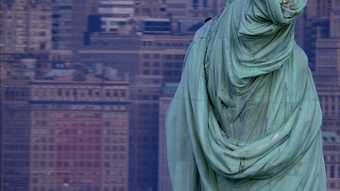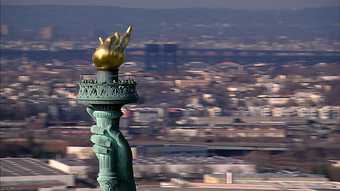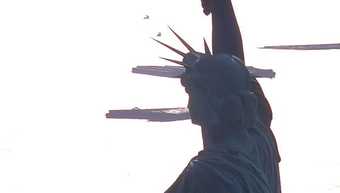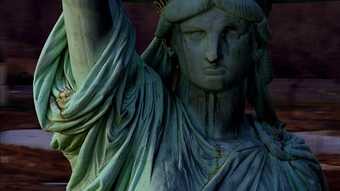Steve McQueen’s seven-minute long film Static 2009 (Tate T13425) is deceptively simple. Shot from a helicopter that persistently circles the Statue of Liberty in New York, McQueen’s 35 mm film, transferred to video, is projected across a large wall in the gallery (figs.1–2). Upon entering the darkened room in which Static is exhibited, the viewer is confronted by the loud, relentless whirr of a helicopter, and a constantly moving aerial view of the iconic statue, with its graphic spiked crown, defiant raised arm, and bold blank facial features all subjected to the enduring scrutiny of McQueen’s camera. With each encircling, the film gets variously closer and farther away from the statue, at one moment highlighting the detailed, stained surface of Liberty’s enormous draped ‘fabric’, and the next demonstrating the dominant position she holds within the surrounding skyline. The digital projection runs on a loop, itself echoing the endless circling of the camera around the stationary monument.

Fig.1
Steve McQueen
Static 2009 (installation shot)
Film, 35 mm, transferred to video, high definition, projection, colour and sound
7 minutes 3 seconds
Tate T13425
© Steve McQueen; courtesy the artist and Thomas Dane Gallery, London
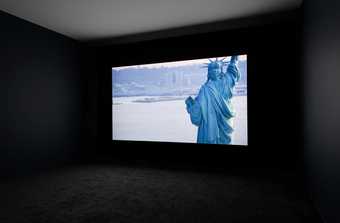
Fig.2
Steve McQueen
Static 2009 (installation shot)
Tate T13425
© Steve McQueen; courtesy the artist and Thomas Dane Gallery, London
Made in 2009, the year that US President Barack Obama reopened the Statue of Liberty to visitors after its closure following the terrorist attacks of 11 September 2001, McQueen’s choice of monument is politically loaded, especially when paired with the idea of stasis. The statue has long-held connotations with freedom and specifically with migration; in the period of the new millennium in which McQueen made this work, the ideals represented by the figure of ‘Liberty Leading the People’ were tested within an increasingly globalised context in which many people were and still are restrained by physical boundaries. At the same time, the motion and noise of the helicopter take on an uncomfortable, sinister overtone, as the dizzying, intense scrutiny of the statue rings with associations of surveillance or threat.
The timing of McQueen’s film was in part a result of his own tourist visit to the Statue, having visited Ellis Island on holiday with his family.1 His remarks to critic Carol Kino in 2010 about his thought processes at the time suggest McQueen’s intention to scrutinise Liberty as both physical object and philosophical concept, and to remove some of the fixity and familiarity of the iconic statue:
‘I saw the Statue of Liberty, and — this is weird — I saw it, and I just had it’, he said. He swiftly decided that he wanted to ‘spin around this thing’. Orbiting the statue allowed him to move it from familiar to unfamiliar, and back again, to ‘put it off-kilter’, he said. ‘But at the same time it’s a physical examination of liberty, of freedom’.2
McQueen shot Static in one day during December 2009 with cameraman Sean Bobbitt, with whom he has worked on many of his projects, including his three feature films.3 McQueen finished editing the artwork in time for its first exhibition, which was aptly held in New York at the Marian Goodman Gallery in January 2010. In her interview with the artist at the time, Kino noted that McQueen compared the process of creating the artwork ‘to training for the 100-meter dash in the Olympics’. ‘It seems to happen very quickly’, McQueen remarked, ‘but all that time you’ve been preparing for the execution of the work’.4 This comment suggests the rich resonances that exist between Static and the rest of McQueen’s growing oeuvre, as well as implying some synergy between the artistic process of creating the work, and the constant movement of the camera within it.
While McQueen’s artwork coincided with the reopening of the Statue to visitors who wanted to climb inside it to the crown, Static itself is quite difficult to view. McQueen’s specifications about the presentation of the film at wall-scale and within a darkened gallery space render it inaccessible to many. What follows is a description of the artwork from one viewer’s perspective. Since the film is shown in the gallery on a loop, meaning viewers would probably enter and exit at varying points without knowing what constituted the ‘beginning’ or ‘end’, the description below aims to communicate something of the film’s intensity and detail.
Experiencing Static
The wall-size screen shows a close-up view of the Statue of Liberty’s side (fig.3). The light green swathes of her garment fill the height of the room, but she moves, shudders, jerks, moving almost out of shot to the left as the camera apparently struggles to remain still and focused on the statue. As she veers from the side to the middle of the screen, sections of New York skyscrapers in the distance shift into focus before also juddering out of shot as the statue seems to shift back towards the centre. As the camera moves and jostles around Liberty, the noise of a helicopter gets louder and louder, building a constant blade-like beating, a whirr that both explains the height and movement of the film while also sounding a sinister note, an ominous mechanical accompaniment to the artwork’s unstable vision.
The camera extends its doddery journey anti-clockwise around the statue, but the film frequently cuts to begin a new span on the same path. From Liberty’s wide girth we are shown her armpit, stained close to the ‘skin’; next her hand supporting the rectangular tablet she holds; then a wider angle shot of her back; next a closer view of the back of her head. The next cut takes us to her other hand, with surprisingly blunt, Lego-like fingers gripping the torch with its static golden flame (fig.4). Each cut offers a ‘look at this’, ‘and this’, ‘and this’ from the artist, yet throughout each new view, the anti-clockwise motion continues, as does the bobbing of the monumental green statue. At no point do we see Liberty as a whole, and at no point is there a sense of straining upwards to see her. The camera is always filming on a horizontal axis, always level with the part of the statue it films, and close enough that Liberty seems to move up and down, the torch in particular apparently dancing around the fixed edges of the gallery’s screen. Throughout, the landscape of New York – half city blocks and half silvery water, boats and iconic bridges – dodges in and out of focus, sometimes functioning as backdrop, sometimes coming to the fore. Some cuts strike the viewer as surrealistic in their choice of focus: we are asked to look at the cylindrical ringlets behind Liberty’s ear, the weathering of her surface, the dirt under her arm, her blackened neck.
With one cut, three minutes into the film, the camera seems to gain steadier focus, and circles around the outstretched shoulder to see Liberty’s face. As it does so, the whirr of the helicopter fades out, and instead we hear the noise of the wind, itself fading at times to almost nothing. In the comparative silence we see Liberty’s neck and head, and struggle to focus on her seemingly blank eyes as still she judders, bobbing up and down. We see her long nose, turning into profile, her scornful mouth, her unflinching stare. We see the rectangular panels which form her mighty upright arm, the lines of which delineate both her engineering prowess and inhuman objecthood. As the camera and unseen helicopter continue their circling, the water and sky become white in front of the statue, and her back becomes greyer and more silhouette-like in the distance, the sun encroaching on her outline, making her seem more mythical than physical (fig.5). Yet with another cut, we are back by her face, this time in a brighter, sunnier light, and the helicopter noise grows again, drowning out the wind. We see the vertical black lines and smudges marking Liberty’s cheek and neck, and the orange light suggestive of human presence within her crown (fig.6). The circling movement and fastidious and frustrating desire to see the statue continues until, towards the very end of this seven-minute film, the helicopter noise once again fades out, and the film seamlessly repeats, opening up once again on Liberty’s juddering core.
Approaches to the film
Static, then, is anything but. Steve McQueen’s artwork presents a dialectic of movement and stasis through the immobility of the statue and the screen, and the inability of the flying camera to remain still. The concise, dense and poetic nature of the artwork means that it does not offer a linear development of its myriad issues and resonances. As a result, while this In Focus project will identify and investigate key aspects of the artwork in turn, there will be some necessary circling between the sections. The project is divided into four key sections: ‘Medium: Seeing, Stasis and Movement’ considers the relationship between stasis and motion, foregrounded by Static, as both a constituent of film as a medium, and essential to the functioning of monuments and the construction of history. ‘Monumentality: the Statue of Liberty as Subject’ extends this discussion by contrasting the aims of those who constructed the – unusually static – vision of Liberty in the nineteenth century with that of more recent viewers, including migrants arriving in New York and contemporary ‘virtual’ visitors to the Statue. ‘Distance: Physical and Political’ discusses the relationship between McQueen’s use of close-up and distant views of the Statue with recent theoretical discussions of the experience of distance under globalisation and its testing through migration, prompting questions about the artist’s and the viewer’s sense of critical distance and responsibility. Finally, in his contribution, ‘The Poetic Nature of Static’, Rod Mengham notes the importance of poetry in the construction of the Statue of Liberty’s meanings, and investigates structural and thematic resonances between Static and literary work by American poet Hart Crane and Irish playwright and poet Samuel Beckett in order to emphasise McQueen’s questioning of state control and reference to the experience of exile. In sum, the project aims to examine this elegiac and complex artwork in depth in order to delineate the provocative questions it raises about freedom, surveillance, migration, and the construction of history.

